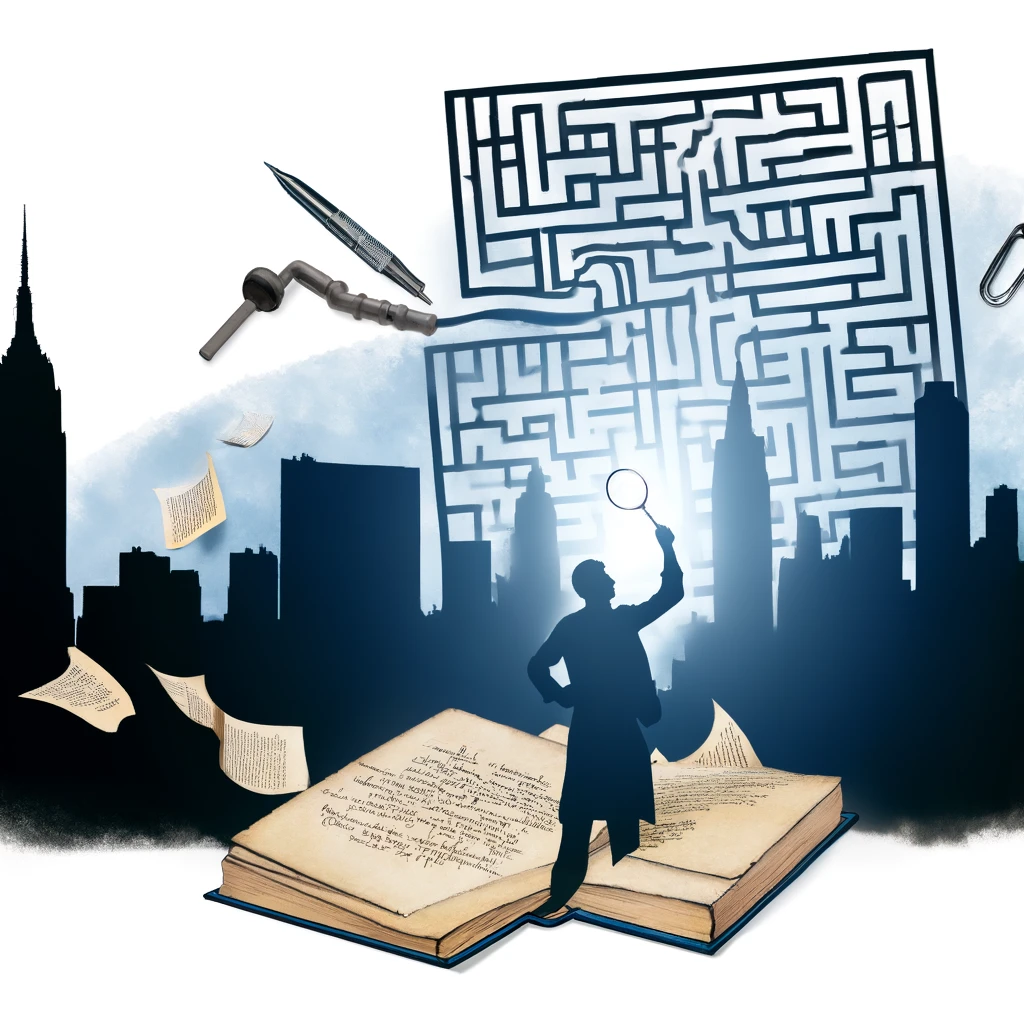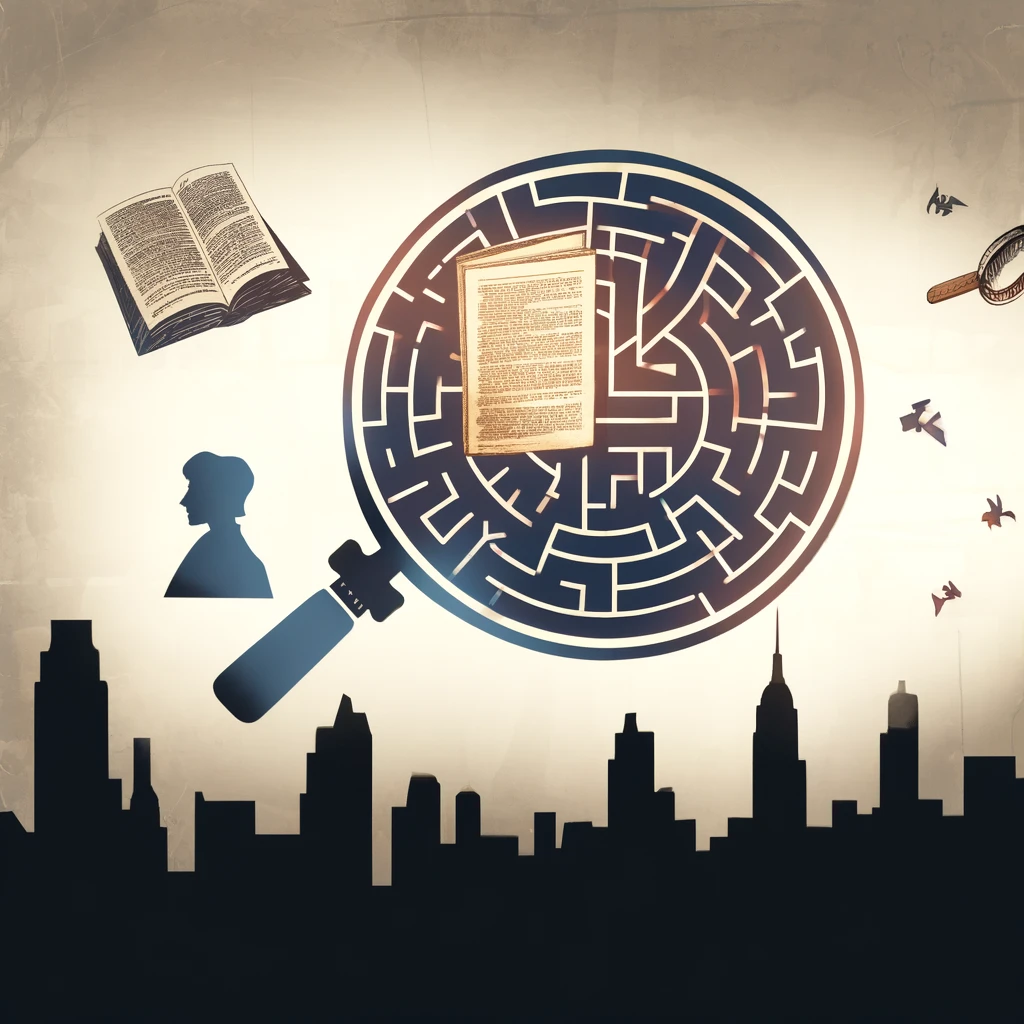
Paul Auster’s “New York Trilogy” is a seminal work in American literature, blending elements of detective fiction with complex existential and philosophical questions. This trilogy, consisting of the novels “City of Glass,” “Ghosts,” and “The Locked Room,” transforms the conventional detective story into a meditation on identity, space, language, and solitude. It stands not only as a profound narrative but also as a deep inquiry into the nature of authorship and the fluid boundaries between fiction and reality.

In “City of Glass,” the first book of the trilogy, we meet Daniel Quinn, a mystery writer who lives a secluded life in New York City. Quinn’s existence is upended when he receives a mysterious phone call seeking a detective, Paul Auster. Quinn, intrigued and compelled by this apparent mistake, assumes Auster’s identity and takes on the case to protect a young man threatened by a shadowy antagonist. The investigation leads Quinn through a labyrinth of clues that eventually cause him to question his own identity and reality. Auster uses the detective genre to explore themes of isolation and the blurring lines between the self and the other.
Paul Auster is dead 2024.
The second novel, “Ghosts,” introduces us to Blue, a private detective hired to watch a man named Black from a rented room across the street. As days turn into months, and his surveillance turns into an obsession, Blue begins to lose his grasp on his own identity, slowly merging with the subject he observes. This story delves deeper into the ideas of surveillance, the act of observation, and how it can transform the observer. “Ghosts” plays with the notions of visibility and invisibility, both literal and metaphorical, exploring how our perceptions of others shape our sense of self.
“The Locked Room” is the trilogy’s final piece, where the themes of the first two novels converge and culminate. The narrator, a nameless writer, receives a manuscript from Fanshawe, his missing friend whose literary executor he becomes. His task is to put Fanshawe’s affairs in order, but as he delves deeper into his friend’s writings and life, he becomes consumed by the mystery of Fanshawe’s disappearance. This quest leads him to question the very nature of identity and creation. The narrative examines the relationships between creator and creation, and the locked room metaphor extends beyond physical spaces to include the constraints of one’s mind and the mysteries within oneself.
Throughout the trilogy, Auster’s New York serves as more than a mere backdrop; it is a vital, living organism that shapes the destinies of his characters. The city is depicted as a maze of endless possibilities and dead ends, mirroring the complex psychological landscapes the characters navigate. The setting of New York acts as a catalyst for existential explorations, providing a space where characters can lose themselves in both physical and metaphysical puzzles.
Auster’s prose is precise and controlled, yet it vibrates with the tension of unanswered questions and unexplained phenomena. His narrative technique often involves stories within stories and plays with different layers of authorship, challenging the reader to discern what is real and what is fabricated. This metafictional approach not only adds depth to the narrative but also comments on the act of storytelling itself. It raises questions about the reliability of narrators and the constructed nature of narratives.
The “New York Trilogy” is ultimately a profound exploration of solitude, identity, and the human condition. Auster’s characters are often solitary figures, grappling with their pasts and the existential dread of their present situations. They wander through a world where the lines between reality and fiction, watcher and watched, writer and character are perpetually blurred. Each novel, while distinct, echoes themes from the others, creating a cohesive yet complex tapestry that invites multiple readings.
Furthermore, Auster’s work reflects on the loneliness inherent in urban lives, where one can be surrounded by millions yet feel profoundly isolated. The trilogy interrogates the ways in which our environments shape us, asking whether we can ever truly know ourselves or others. Each character’s journey is a deep dive into the psyche, where the search for truth often leads to more questions than answers.
Paul Auster’s “New York Trilogy” redefines the boundaries of traditional detective fiction and engages deeply with philosophical themes. It is a cornerstone of postmodern literature, offering a narrative that is as haunting as it is enlightening. By the end of the trilogy, readers are left with a deeper understanding of the complexity of human nature and the profound effects of narrative on our perception of reality. Auster’s trilogy is not just a set of books about New York; it is a compelling inquiry into the deepest questions of existence, making it a lasting contribution to American literature and a pivotal read for those who ponder the mysteries of life and art.
Indeed, the “New York Trilogy” by Paul Auster is a singular volume consisting of three interconnected stories that collectively weave a complex narrative exploring themes of identity, surveillance, isolation, and the boundaries of fiction and reality. This structure allows Auster to delve into various aspects of the narrative and philosophical inquiry while maintaining a cohesive overarching theme.
The interconnectivity of the three tales enhances the overarching exploration of identity and existence. The protagonists in each story, while engaged in their detective-like pursuits, find themselves questioning the very nature of their realities. These existential queries are magnified by the characters’ interactions with the city and the text, which often acts as a mirror reflecting their deepest anxieties and doubts. Auster plays with literary conventions, merging the detective genre with existential literature, resulting in a complex narrative puzzle.
Each segment of the trilogy, while it can stand alone in its narrative arc, gains greater depth and resonance from its relationship to the others. For instance, the mysterious writer figure who appears in “City of Glass” becomes a central focus in “The Locked Room,” connecting the narratives and blurring the lines between the creator and the created, observer and participant. This layering of roles and identities is reflective of the multifaceted nature of human perception and the often elusive quest for personal meaning and truth.
Auster’s use of the city as a labyrinth is crucial to the thematic and structural composition of the work. New York, with its endless streets, myriad inhabitants, and labyrinthine architecture, acts as a metaphor for the complexities of the human mind. The city’s ability to both hide and reveal secrets parallels the internal journeys of the characters, who navigate their paths laden with philosophical and psychological riddles. The urban environment, with its simultaneous offerings of anonymity and intimacy, perfectly complements the solitude and introspection of the characters, heightening the existential stakes of their quests.
The narrative technique in the “New York Trilogy” is also a notable aspect, where Auster employs a postmodern approach to storytelling. By embedding various textual layers and employing metafictional techniques, he not only challenges the reader’s perception of the narrative but also comments on the act of storytelling itself. This approach questions the authenticity of narrative voices, the reliability of texts, and the construction of identity through stories. Such a technique invites the reader to engage actively with the text, deciphering meanings and connections that lie beneath the surface of the narrative.
Moreover, Auster’s exploration of loneliness and isolation in an urban setting raises poignant questions about modern existence. His characters, often isolated despite the crowded city around them, reflect the alienation and fragmentation of contemporary life. This theme resonates deeply with readers, who may recognize their own struggles with identity and meaning within the urban sprawl. The trilogy’s focus on solitude amidst the cacophony of the city underscores a universal search for connection and understanding in a seemingly indifferent world.
Ultimately, the “New York Trilogy” by Paul Auster is a profound meditation on the human condition. It challenges and expands the conventions of detective fiction to explore deeper philosophical questions. It is a testament to Auster’s ability to craft a narrative that is both intellectually engaging and deeply human. The trilogy remains a critical work for understanding the interplay between narrative structure, identity formation, and the existential dilemmas of modern life, making it a pivotal addition to the landscape of American literature.
Images inspired by “Postmodern Puzzles: A Closer Look at Paul Auster’s New York Trilogy.” The illustrations feature an intricate maze overlaid on the silhouette of New York City’s skyline, with elements like scattered manuscript pages and a magnifying glass, capturing the mysterious and thought-provoking themes of the novels.